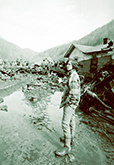Buffalo Creek Dam Disaster
The Buffalo Creek flood was a disaster that occurred on February 26, 1972, when the Pittston Coal Company's coal slurry impoundment dam #3, located on a hillside in Logan County, West Virginia, burst, four days after having been declared "satisfactory" by a federal mine inspector.
 The resulting flood unleashed approximately 132,000,000 US gallons (500,000 m3) of black waste water, cresting over 30 ft high, upon the residents of 16 coal towns along Buffalo Creek Hollow. Out of a population of 5,000 people, 125 were killed, 1,121 were injured, and over 4,000 were left homeless. 507 houses were destroyed, in addition to forty-four mobile homes and 30 businesses. The disaster destroyed or damaged homes in Saunders, Pardee, Lorado, Craneco, Lundale, Stowe, Crites, Latrobe, Robinette, Amherstdale, Becco, Fanco, Braeholm, Accoville, Crown and Kistler. In its legal filings, Pittston Coal referred to the accident as "an Act of God."
The resulting flood unleashed approximately 132,000,000 US gallons (500,000 m3) of black waste water, cresting over 30 ft high, upon the residents of 16 coal towns along Buffalo Creek Hollow. Out of a population of 5,000 people, 125 were killed, 1,121 were injured, and over 4,000 were left homeless. 507 houses were destroyed, in addition to forty-four mobile homes and 30 businesses. The disaster destroyed or damaged homes in Saunders, Pardee, Lorado, Craneco, Lundale, Stowe, Crites, Latrobe, Robinette, Amherstdale, Becco, Fanco, Braeholm, Accoville, Crown and Kistler. In its legal filings, Pittston Coal referred to the accident as "an Act of God."
Dam #3, constructed of coarse mining refuse dumped into the Middle Fork of Buffalo Creek starting in 1968, failed first, following heavy rains. The water from Dam #3 then overwhelmed Dams #2 and #1. Dam #3 had been built on top of coal slurry sediment that had collected behind dams # 1 and #2, instead of on solid bedrock. Dam #3 was approximately 260 feet above the town of Saunders when it failed. More details
 The resulting flood unleashed approximately 132,000,000 US gallons (500,000 m3) of black waste water, cresting over 30 ft high, upon the residents of 16 coal towns along Buffalo Creek Hollow. Out of a population of 5,000 people, 125 were killed, 1,121 were injured, and over 4,000 were left homeless. 507 houses were destroyed, in addition to forty-four mobile homes and 30 businesses. The disaster destroyed or damaged homes in Saunders, Pardee, Lorado, Craneco, Lundale, Stowe, Crites, Latrobe, Robinette, Amherstdale, Becco, Fanco, Braeholm, Accoville, Crown and Kistler. In its legal filings, Pittston Coal referred to the accident as "an Act of God."
The resulting flood unleashed approximately 132,000,000 US gallons (500,000 m3) of black waste water, cresting over 30 ft high, upon the residents of 16 coal towns along Buffalo Creek Hollow. Out of a population of 5,000 people, 125 were killed, 1,121 were injured, and over 4,000 were left homeless. 507 houses were destroyed, in addition to forty-four mobile homes and 30 businesses. The disaster destroyed or damaged homes in Saunders, Pardee, Lorado, Craneco, Lundale, Stowe, Crites, Latrobe, Robinette, Amherstdale, Becco, Fanco, Braeholm, Accoville, Crown and Kistler. In its legal filings, Pittston Coal referred to the accident as "an Act of God."Dam #3, constructed of coarse mining refuse dumped into the Middle Fork of Buffalo Creek starting in 1968, failed first, following heavy rains. The water from Dam #3 then overwhelmed Dams #2 and #1. Dam #3 had been built on top of coal slurry sediment that had collected behind dams # 1 and #2, instead of on solid bedrock. Dam #3 was approximately 260 feet above the town of Saunders when it failed. More details
